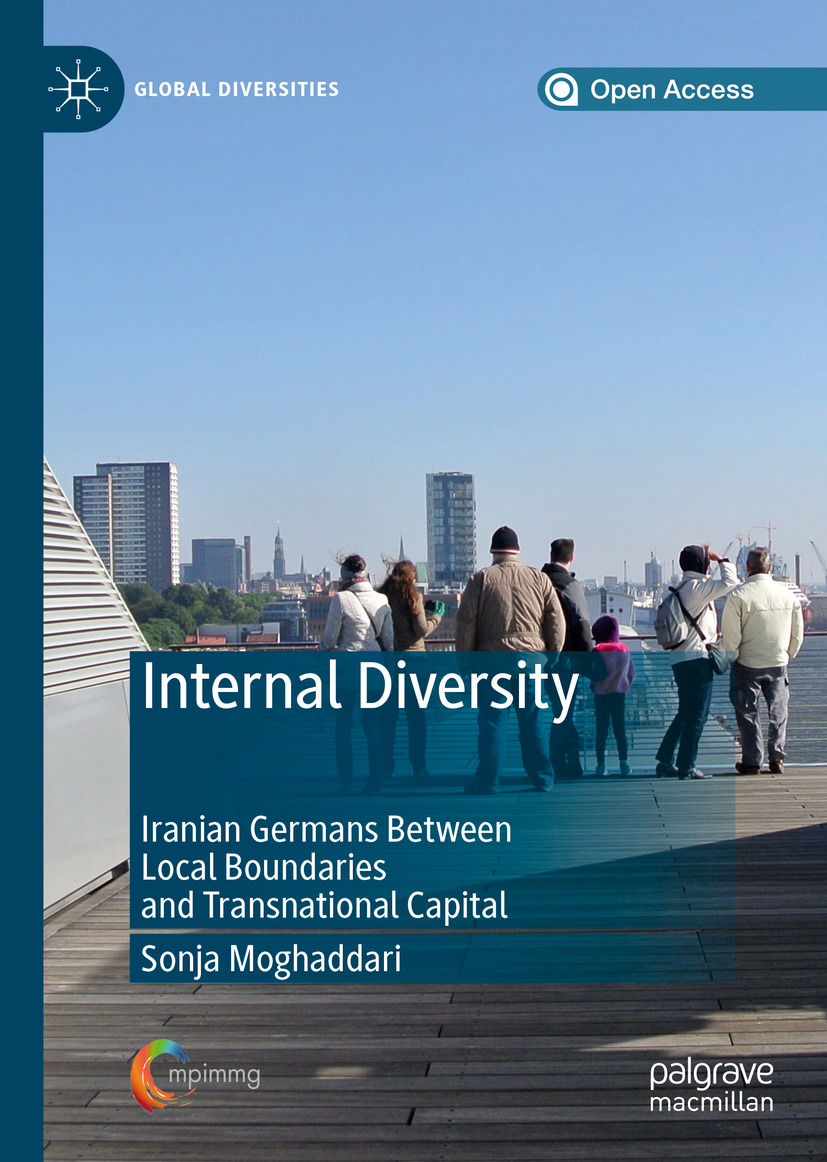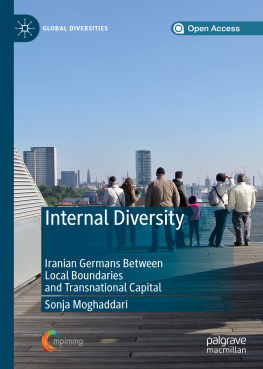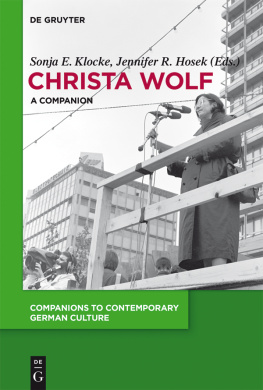Sonja Moghaddari - Internal Diversity: Iranian Germans Between Local Boundaries and Transnational Capital
Here you can read online Sonja Moghaddari - Internal Diversity: Iranian Germans Between Local Boundaries and Transnational Capital full text of the book (entire story) in english for free. Download pdf and epub, get meaning, cover and reviews about this ebook. year: 2020, publisher: Springer Nature, genre: Politics. Description of the work, (preface) as well as reviews are available. Best literature library LitArk.com created for fans of good reading and offers a wide selection of genres:
Romance novel
Science fiction
Adventure
Detective
Science
History
Home and family
Prose
Art
Politics
Computer
Non-fiction
Religion
Business
Children
Humor
Choose a favorite category and find really read worthwhile books. Enjoy immersion in the world of imagination, feel the emotions of the characters or learn something new for yourself, make an fascinating discovery.
- Book:Internal Diversity: Iranian Germans Between Local Boundaries and Transnational Capital
- Author:
- Publisher:Springer Nature
- Genre:
- Year:2020
- Rating:5 / 5
- Favourites:Add to favourites
- Your mark:
- 100
- 1
- 2
- 3
- 4
- 5
Internal Diversity: Iranian Germans Between Local Boundaries and Transnational Capital: summary, description and annotation
We offer to read an annotation, description, summary or preface (depends on what the author of the book "Internal Diversity: Iranian Germans Between Local Boundaries and Transnational Capital" wrote himself). If you haven't found the necessary information about the book — write in the comments, we will try to find it.
Sonja Moghaddari: author's other books
Who wrote Internal Diversity: Iranian Germans Between Local Boundaries and Transnational Capital? Find out the surname, the name of the author of the book and a list of all author's works by series.
Internal Diversity: Iranian Germans Between Local Boundaries and Transnational Capital — read online for free the complete book (whole text) full work
Below is the text of the book, divided by pages. System saving the place of the last page read, allows you to conveniently read the book "Internal Diversity: Iranian Germans Between Local Boundaries and Transnational Capital" online for free, without having to search again every time where you left off. Put a bookmark, and you can go to the page where you finished reading at any time.
Font size:
Interval:
Bookmark:

Over the past decade, the concept of diversity has gained a leading place in academic thought, business practice, politics and public policy across the world. However, local conditions and meanings of diversity are highly dissimilar and changing. For these reasons, deeper and more comparative understandings of pertinent concepts, processes and phenomena are in great demand. This series will examine multiple forms and configurations of diversity, how these have been conceived, imagined, and represented, how they have been or could be regulated or governed, how different processes of inter-ethnic or inter-religious encounter unfold, how conflicts arise and how political solutions are negotiated and practiced, and what truly convivial societies might actually look like. By comparatively examining a range of conditions, processes and cases revealing the contemporary meanings and dynamics of diversity, this series will be a key resource for students and professional social scientists. It will represent a landmark within a field that has become, and will continue to be, one of the foremost topics of global concern throughout the twenty-first century. Reflecting this multi-disciplinary field, the series will include works from Anthropology, Political Science, Sociology, Law, Geography and Religious Studies. While drawing on an international field of scholarship, the series will include works by current and former staff members, by visiting fellows and from events of the Max Planck Institute for the Study of Religious and Ethnic Diversity. Relevant manuscripts submitted from outside the Max Planck Institute network will also be considered.
More information about this series at http://www.palgrave.com/gp/series/15009


Open AccessThis book is licensed under the terms of the Creative Commons Attribution 4.0 International License (http://creativecommons.org/licenses/by/4.0/), which permits use, sharing, adaptation, distribution and reproduction in any medium or format, as long as you give appropriate credit to the original author(s) and the source, provide a link to the Creative Commons licence and indicate if changes were made.
The images or other third party material in this book are included in the book's Creative Commons licence, unless indicated otherwise in a credit line to the material. If material is not included in the book's Creative Commons licence and your intended use is not permitted by statutory regulation or exceeds the permitted use, you will need to obtain permission directly from the copyright holder.
Cover image Sonja Moghaddari
This Palgrave Macmillan imprint is published by the registered company Springer Nature Switzerland AG.
The registered company address is: Gewerbestrasse 11, 6330 Cham, Switzerland
To my loved ones
Past, present, and future
Writing this book seemed to me like doing pottery: over and over, I looked at the clay, I weighted it in my hands, wedged it, molded it to sculpt it into a form I thought was fitting. Then I set it aside, but looking at it again after a while, I tried out new shapes, until I had it standing stably on its own. I am very happy and incredibly grateful for having had the chance to have numerous people who, each in their own way, accompanied me through all the different stages of this research and writing experience.
I would not have been able to write this book without the open-mindedness and the interest of my interlocutors in Hamburg and elsewhere, who allowed me to dive into their world and carry out in-depth long-term ethnographic fieldwork. To each and every one of them, I am highly indebted. As it is impossible to cite them all, I would like to stress my particular gratitude to Babak, Milad, and Solmaz, who did not only share their thoughts and experiences, but also offered me their friendship. My special thanks go also to Siavash, who shared my fascination with the history of Hamburgs early Iranian merchants. Many thanks to Behruz for having allowed me to be anot always easyvolunteer in the Color festival, and to the Golestanis who helped me to develop new feelings of belonging.
This book would not have taken the shape it did without the inspiration of brilliant, insightful, and supportive colleagues and mentors. I am particularly grateful to Alessandro Monsutti not only to have allowed me to deepen my understandings of transnational inequality, but also for his availability and reliability as an advisor during my doctorate, on which this book is drawing. A thousand thanks to Christian Bromberger who has been a serene, engaging mentor and an important model of a mindful ethnographer, since he sparked my interest in the anthropology of Iran when I first met him as an undergraduate student in Hamburg.Dast-e shom dard nakone. As a third mentor and friend, I will thank Cristian Alvarado Leytons encouraging guidance and uneasy questions. He taught me to believe in myself and the value of migrants becoming anthropologists.
I am thankful to Yvan Droz, Sandro Cattacin, and Sabine Strasser for their thoughtful comments on earlier versions of this work as members of my thesis committee. I further wish to thank Frdric Saumade, Shalini Randeria, Gaetano Ciarcia, Anja Weiss, Thomas Faist, Anne-Christine Trmon, Susanne Bygnes, and Amin Moghaddam for academic guidance and constructive feedback. I thank Steven Vertovec for his support as a mentor and series editor. Thanks also to Christiane Kofri, Birgitt Sippel and the Palgrave team for the logistical help in the publishing process.
Font size:
Interval:
Bookmark:
Similar books «Internal Diversity: Iranian Germans Between Local Boundaries and Transnational Capital»
Look at similar books to Internal Diversity: Iranian Germans Between Local Boundaries and Transnational Capital. We have selected literature similar in name and meaning in the hope of providing readers with more options to find new, interesting, not yet read works.
Discussion, reviews of the book Internal Diversity: Iranian Germans Between Local Boundaries and Transnational Capital and just readers' own opinions. Leave your comments, write what you think about the work, its meaning or the main characters. Specify what exactly you liked and what you didn't like, and why you think so.












